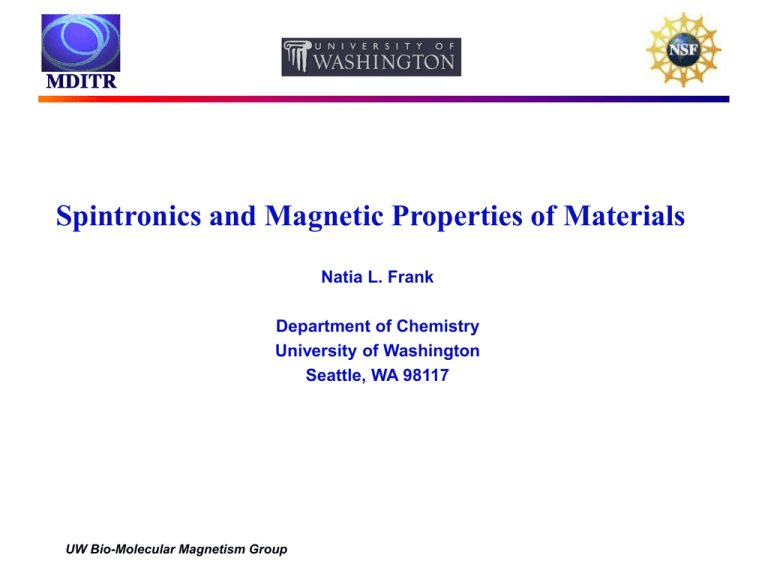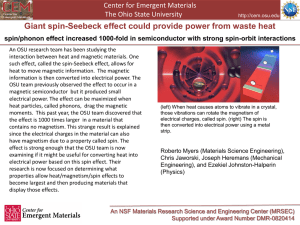Tutorial_Frank_Magnetism
advertisement

Spintronics and Magnetic Properties of Materials Natia L. Frank Department of Chemistry University of Washington Seattle, WA 98117 UW Bio-Molecular Magnetism Group The Earth’s Magnetic Field Glatzmaier (Los Alamos) UW Bio-Molecular Magnetism Group Alerstam, Nature 2001 Navigating the Earth’s Magnetic Field Magnetoreception: How organisms use magnetic information to control and direct their behavior •Magnetotaxis: movement along field lines: alignment •Menotaxis (Kuhn) compass orientation with respect to external field UW Bio-Molecular Magnetism Group Early Magnetism Origin of the name “magnetism”: Magnesia (Thessaly, Greece) Greeks: Lodestone FeO-Fe2O3 “leading stone or compass” “The magnet’s name the observing Grecians drew From the magnetick region where it grew”- Lucretius Carus 100B.C. “The nails of whose shoes and the tip of whose staff stuck fast in a magnetick field while he pastured his flocks”-Pliny the Elder(Magnus) Greek Writings: Lodestone appeared as early as 800 B.C. UW Bio-Molecular Magnetism Group Gilbert: The Father of Magnetism 1600. William Gilbert: “ Father of Magnetism “ b. 1544. London physician, physics by hobby. Queen Elizabeth’s personal physician. d. 1603 plague. “ it is easy for men of acute intellect to slip and err”. Treatise “ On the Magnet: Magnetic Bodies Also, and On the Great Magnet the Earth; a New Physiology, Demonstrated by Many Arguments and Experiments” UW Bio-Molecular Magnetism Group Magnetic Field Vector H The density of lines is proportional to the magnitude of the magnetic field vector. Fk UW Bio-Molecular Magnetism Group m1 m 2 r0 2 r H m 2 r0 r Quantum Mechanical Basis of Spin Rotation of the charge of an electron produces current loops with a magnetic moment directed along the rotation axis:spin angular momentum. Origin of magnetic moment: orbital angular momentum(a) and spin angular momentum(b). Bohr Magneton (mB or b ) = eh/4pmc = 9.27 x 10-21 erg/Oe UW Bio-Molecular Magnetism Group Magnetization (M) and Induction(B)Vectors Magnetic dipole moment: m : m = 1 when a force of 1 dyne is experienced in a field of 1 oersted. Magnetic Induction, B = H + DH measured in gauss (G) and H in oersted (Oe) Intensity of magnetization (magnetic dipole moment / unit volume) = M (emu/cm3) In cgs units, DH = 4pM, therefore, B = H + 4pM. The magnetic induction is equal to the external field corrected for the magnetization of the substance. UW Bio-Molecular Magnetism Group Magnetic Susceptibility and Permeability When the vectors B, H and M are parallel, it is useful to define the magnetic permeability(m) and magnetic susceptibility(c) of a substance: B mH M c/H Define M/H = cV where cV is the volume magnetic susceptibility and is dimensionless. Gram Susceptibility, cg = cV / r (cm3 g-1) where r is the density Molar Susceptibility, cM = cg *molecular weight and is in units of (emu/cm3•G•mol) The magnetic susceptibility and permeability characterize the type of magnetism observed: diamagnetism, paramagnetism, ferromagnetism, or antiferromagnetism UW Bio-Molecular Magnetism Group Types of Magnetism (a) Diamagnetism: c < 0, 10-6 emu, c independent of H, origin field induced, paired electron circulation. (b) Paramagnetism c > 0, 0 to10-4 emu, c independent of H, origin angular momentum of electron. No interactions between spins. (c) Ferromagnetism c > 0, 10-4 to 10-2 emu, c dependent on H, spin alignment from dipole-dipole interaction of moments or intramolecular exchange coupling. high spin ground state. (d) Antiferromagnetism c > 0, 0 to10-4 emu, c dependent on H, origin field induced, spin pairing from dipole-dipole interaction or intramolecular exchange coupling. low spin ground state. (e) Ferrimagnetism c > 0, 10-4 to 10-2 emu, c dependent on H, origin field induced, spin pairing (antiferromagnetic coupling) of two species with different magnetic moments from dipole-dipole interaction or intramolecular exchange coupling. leads to net magnetization Unpaired e- Paired e- (a) (b) UW Bio-Molecular Magnetism Group (c) (d) (e) Diamagnetism Theory of Diamagnetism: Langevin (1905) • Paired electrons produce a current loop that repels an external magnetic field. c • • • m0 Nm B m0 NZe2 6m r2 (Classical Langevin result) Diamagnetic susceptibilities are negative (c < 0), independent of field and temperature. Must be taken into account in the measurement of paramagnetic susceptibilities: c= cp + cdia Diamagnetic corrections can be calculated using Pascal’s constants and are always negative. Nijmegen High Field Magnet Laboratory, Netherlands UW Bio-Molecular Magnetism Group Superconductors: The Perfect Diamagnet Superconductivity: 1911: Heike K. Onnes noted that the resistance of a frozen mercury rod suddenly dropped to zero when cooled to the boiling point of helium (4.2 Kelvin). The conductivity occurs with zero resistance, and probably involves the formation of “Cooper pairs”. The mechanism of cooper pair formation is still under investigation. Meissner effect: Magnetic fields are excluded from superconductors below their Tc YBa2Cu3O7 (YBCO) Images cortesy of ILL-France UW Bio-Molecular Magnetism Group YBa2Cu3O6 Levitation at T<Tc Paramagnetism Theory of Paramagnetism: Curie (1907) • • Unpaired electrons produce an induced field that attracts an external magnetic field. Paramagnetic susceptibilities are positive (c > 0), dependent on field and temperature. apply Field (H) B Random alignment of spins UW Bio-Molecular Magnetism Group Partial alignment of spins: c increases Paramagnetism: gbH vs. kT Alignment of spins with field m = -gbS DE = -2 gbSH = 2 m UW Bio-Molecular Magnetism Group Randomization of spins Fundamental Law in Magnetism: Van Vleck No angular momentum and no coupling between ground and excited state: magnetic moment= -gbH interacting with magnetic field:Hamiltonian: = -gbH S operate Hamiltonian on spin wavefunction: two eigenvalues are obtained: E=ms gbH mm E / H (microscopic magnetization) Macroscopic magnetization: Application of Boltzmann distribution M=f (NgbkT) For ms=1/2: gbH gb H exp exp Ngb 2kT 2kT M gb H gbH 2 exp exp 2kT 2kT Valid for H / kT<<1 H large, T low: Msat = N gb S H moderate, T moderate: Curie Law UW Bio-Molecular Magnetism Group Paramagnetism: Curie Law The dependence of the magnetic susceptibility with temperature for spin only systems is governed by the Curie Law. Before quantum mechanics:(Curie, 1900) c = C/T, where C = Curie Constant After quantum mechanics: (Van Vleck, 1931) c = Ng2b2 S(S+1) / 3kT Magnetic Moment Susceptibility 5 c (emu•K/cm3•G•mol) c (emu/cm3•G•mol) 2 [Cu(H20)6](SO4)2 S = 1/2 1.5 [Ni(H20)6](SO4)2 S = 1 [Mn(H20)6](SO4)2 S = 5/2 1 0.5 0 0 20 40 60 80 T(K) UW Bio-Molecular Magnetism Group 100 120 4 m(BM ) 2.828 cT 3 2 1 0 0 50 100 150 T(K) 200 250 300 Diamagnetism vs. Paramagnetism UW Bio-Molecular Magnetism Group Paramagnetic Susceptibility of Conduction Electrons Pauli paramagnetism: Only the fraction T/TF contribute to the susceptibility. 3Nm 2 M H 2kB TF UW Bio-Molecular Magnetism Group Field dependence of the Magnetization Brillouin Function M = NgJmBBJ(x) 2S 1 1 x 2S 1 BJ (x) coth x coth 2S 2S 2S 2S x gJmB B /k B T Assumptions made: x<<1 ( gJmBB << kBT) W. E. Henry UW Bio-Molecular Magnetism Group “Spin-only” Magnetism Spin only magnetism refers to systems in which there is no orbital angular momentum, and no exchange interactions (No spin orbit coupling, g-anisotropy, zero field splittings, exchange interactions) UW Bio-Molecular Magnetism Group Deviations from “Ideal behavior”: The Curie-Weiss Law Deviations from Curie Law behavior may be due to internal electronic structure ( g-anisotropy, ZFS, spin-orbit coupling) or magnetic exchange interactions which lead to an additional mean field, causing a different distribution of spin states. If the mean field is small relative to the splitting of original states, the magnetic susceptibility follows the Curie Weiss Law: c C T where is essentially a mean field parameter. UW Bio-Molecular Magnetism Group Magnetic Exchange Interactions Magnetic exchange interactions between two spin containing units depends to a first approximation on the orbital overlap either directly through space (direct exchange) or through bond (spin delocalization, spin polarization or superexchange). S=1 S=0 2J 2J S=1 Ferromagnetic Antiferromagnetic exchange exchange 2J = interaction between unpaired spins UW Bio-Molecular Magnetism Group S=0 What is Exchange??? Exchange interaction: spin dependent coulomb energy Exchange energy ( Exchange Field): If two atoms i and j have spin angular momentum Sih/2p and Sjh/2p, respectively, then the exchange energy between them can be described in terms of the exchange integral Jex. E ex 2J ex Si S j (e1 e 2 ) 2 J ex 2k U Kinetic energy term (antiferromagnetic) and potential energy term (ferromagnetic): (e1 e2 ) 2 4(b l)2 J AF U U UW Bio-Molecular Magnetism Group JF 2k Dimer Model for Magnetic Exchange Hamiltonian: H 2 Jij Si S j Summing over states: isotropic Heisenberg Hamiltonian H 2JS1 S2 J = E (S=0) - E (S=1) which is the isotropic interaction parameter. In this case, J < 0 is antiferromagnetic coupling, while J > 0 is ferromagnetic coupling. c 2Ng2 b 2 / kT Bleaney Bowers (1952) 3 exp(2J / kT) UW Bio-Molecular Magnetism Group Types of Magnetism Diamagnetic UW Bio-Molecular Magnetism Group Magnetic Ordering T > Tc: paramagnet T < Tc:Ferromagnet Fe (Tc = 1043K) Ni (Tc = 631K) CrO2 (Tc = 387K) CrBr3 (Tc = 33K) UW Bio-Molecular Magnetism Group T < Tc: Antiferromagnet Cr (Tc = 313K) Mn (Tc = 95K) NiO (Tc = 523K) MnO (Tc = 120K) Long Range Order: Antiferromagnetism UW Bio-Molecular Magnetism Group Long Range Order: Ferromagnetism Large magnetization energies associated with ferromagnetism give rise to formation of domain walls. Driving force? Magnetostatic energy. UW Bio-Molecular Magnetism Group Hysteresis: Hard and Soft Magnets UW Bio-Molecular Magnetism Group Single Domain Particles First postulated in 1930 by Frenkel and Dorfman Single domain particles cannot be demagnetized (no domain walls), their magnetization can only be reversed by rotation. UW Bio-Molecular Magnetism Group Magnetic Nanoparticles Behavior of nanoparticles is a function of structure, size, and interactions in the material. single domain Hc multidomain Superparamagnetic D Dc UW Bio-Molecular Magnetism Group Spintronics Spintronics: Spin-polarized charge transport Spin orientation of conduction electrons has is a slow process (ns), compared to the rate of electron momentum decay (fs). Applications: quantum computing, (each spin corresponds to a bit “qubit”) magnetic information storage(GMR) magnetic hard drives M-RAM (GMR-RAM) nonvolatile programmable logic(AND, OR, NAND and NOR gates) NY Times, (IBM) 2001 UW Bio-Molecular Magnetism Group Nature June 2000 Magnetoresistance Prinz(1998) UW Bio-Molecular Magnetism Group Spin Valves A general magnetic field sensor made of GMR multilayers (iron-nickel with silver) (Institute of Physics) UW Bio-Molecular Magnetism Group Dilute Magnetic Semiconductors (DMS) Can spin polarized transport be realized in semiconductor structures? semiconductor quantum dots, atoms, or molecules quantum bits (qubits) for quantum computing and quantum communication. ferromagnetic semiconductors = charge transport and magnetic storage. Challenges: ferromagnetic material ( with high Tc) effective spin-injection (100% ideally) resistivity comparable to that of a semiconductor for effective band matching. Mn-based zinc-blende III-V and II-VI magnetic semiconductors: hole-mediated exchange based on the Zener model (double exchange) correctly predicts the magnetic exchange in these systems. UW Bio-Molecular Magnetism Group RKKY Theory The phenomenon of magnetic exchange in electron-delocalized solid state materials was described for magnetically dilute semiconductors by Kondo, Heeger and Ruderman and Kittel, Kasuya, and Yosida. Indirect exchange interaction between the two magnetic ions that occurs through electron scattering and hyperfine interactions between the scattered electron and magnetic nucleus. The conduction gas is magnetized in the vicinity of the magnetic ion; the second ion perceives the magnetization of the first, leading to an interaction between them, known as the Friedel or RKKY interaction. UW Bio-Molecular Magnetism Group Kondo Effect The Kondo Effect is a minimum in the electrical resistivity-temperature curve of dilute magnetic alloys at low temperatures. Anomalously high scattering probability: dynamic nature of the scattering of the exchange coupling, and of the sharpness of the Fermi surface at low temperatures. The spin dependent contribution to the resistivity is dependent on the exchange energy, nearest neighbors, and strength of exchange scattering. (Experiment: MacDonald) 0.090 0.200 (Theory:Kondo) Resistance() Au(Fe) 0.08%Fe 0.006%Fe minimum 0.074 UW Bio-Molecular Magnetism Group 0.184 T(K) Kondo effect in single-atom transistors UW Bio-Molecular Magnetism Group Park, Pasupathy Nature 2002







